Battle of Khalkhin Gol (II)
- By Peter Harmsen
- 15 September, 2013
- No Comments
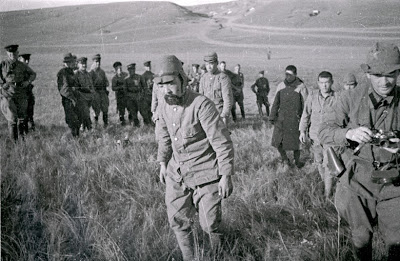
Japanese soldiers considered it a huge humiliation to be taken prisoner. As the photo on the left shows, it happened for many of them in the summer of 1939, when they clashed with Soviet troops on the border of China and Mongolia. The battle was a pivotal event, even if it is not widely known outside professional military history circles. This is the second and last installment of an article first carried by the Warfare History Blog.
Weapons systems and unit level strategy of the Imperial Japanese Army throughout the conflict were centered around the aggressive tactics of the riflemen’s platoon supported by mortar fire and anti-tank artillery pieces. Doctrine of this period held that tanks were to be used in small numbers, piecemeal as shock or support units. This same doctrine stressed that the tank commanders cover the advance of infantrymen from a distance of around three miles using advance and fire techniques. [6] Overall Kwantung Army doctrine held firmly that the infantry and the air squadrons alone could defeat the Bolshevik army conscripts who the IJA had a low opinion of as fighting men dating back to the intervention during the Civil War.
During Nomonhan and in the later Pacific conflict, Japanese infantryman were issued the Arisaka rifle, a family of long barreled bolt action rifles dating back to the Meiji era in chambered in 6.5 and 7.7 mm. These firearms were generally considered outdated for their time and were one of the least effective service rifles issued from any major nation who fought in World War II. Officers, tank crewmen, and pilots carried an example of another poorly designed modern weapon in the Nambu pistol, an under powered 8×22 mm handgun prone to jamming which was also apparently difficult to fire with gloved hands. This was an obvious problem for the men trying to protect themselves from swarms of mosquitoes on the battlefield during the Nomonhan Incident.
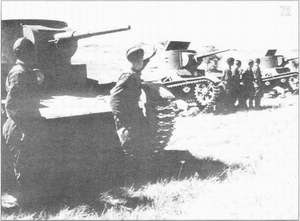
Soviet T-26 light tanks of the 36th Motorised Rifle Division
The Samurai sword was a weapon of great cultural importance to the IJA, used ceremoniously as well as in combat throughout 1931-1945. It was still feared by Japan’s adversaries during this time and revered as a trophy of war as well. Typically swords were issued or carried by all officers and some NCO’s who still tried to retain the trappings of Bushido and the code of honor and chivalry that made surrender a non-possibility for most, and death in the service to the Emperor preferable to dishonorable surrender. These swords were still deadly in actual combat even in 1939 as many Japanese officers proved, they wielded not just relics or family heirlooms from the days of the feudal Samurai but also mass-produced military issue Type 94 and Type 95 swords, not known for their quality or durability however. Accounts from both sides note the fear that Samurai swords inspired in the young and inexperienced conscript Red Army soldiers.
Conversely many of the younger Japanese officers rejoiced in seeing combat for the first time during the ever increasing night raids of June and July. Accounts from both sides note routs turned massacres of frightened Russians soldiers by aggressive IJA bayonet and sword charges especially when they went on the offensive early in the conflict. The Samurai sword is synonymous with Bushido and vice versa. The ethos that arguably defines the history of Japans military forces from the medieval ages until 1945, Bushido manifests itself during the Battle of Khalkhin Gol through the IJA platoons that were sent as tank-killer teams to destroy Soviet armor or machine gun emplacements.
Another example would be the practice of Seppuku, the Samurai’s ancient form of ritualistic suicide by both infantry and tank officers who had failed in their assaults during the battle. Despite these examples many officers were still shocked when they witnessed from afar their soldiers surrendering in late August in face of the Soviet onslaught. Bushido arguably also led to the long record of atrocities against POW and surrendering troops evident in the accounts of IJA soldiers forcing surrendered Russian soldiers from their tanks and then killing them with bayonets and swords. Overall the edge in fighting prowess between the two opposing infantries must be given to the IJA because of not just their bravery but of their tactical mastery of assault, recon, and ambush/counter attack strategies as evident in their operations during Battle of Khalkhin Gol. It was the Red Army and their Mongolian allies, using their superior manpower and logistical support with overwhelming armor support tactics however who were able to score an absolutely decisive victory against a better opponent at least soldier to soldier.
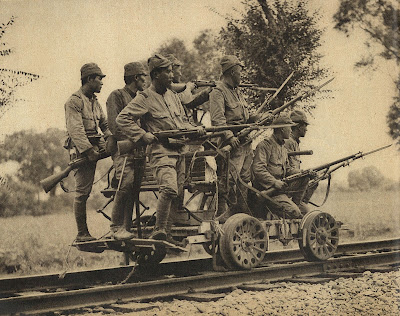
Japanese infantry in 1937
Mass infantry assaults with the full integration of motorized forces, coupled with heavy artillery cover and mortar support at the rifle unit level was the key to advancing against the stubborn IJA defense. Zhukov’s final push from August 20 to September 1st 1939 was most certainly a strategic and tactical masterpiece in every sense because he grasped the use of his forces as being a single entity designed for one single purpose in the given theatre of operations. Later showing the strategic command and bold initiative that would make him more successful than the American Civil War General, George B. McClellan (b.1826-1885), who Stalin famously compared Zhukov to in 1942 within the context of the campaign on the Eastern Front.
More impressively Zhukov designed a winning strategy that destroyed a heavily defended opponent better trained than even his crack units like the border guards or airborne brigade, by a decisive encirclement and destroy action designed to achieve total victory, decisively at any cost to man or in material. This massive combined arms assault would prove a highly effective but difficult tactic to implement on the unforgiving terrain of Finland during the Winter War of 1939-1940. It was later successfully used by Zhukov on the Eastern Front against the Nazi’s and their allies from 1942-1945.
As August approached General Zhukov was pooling his resources and armor brigades for a large combined assault across all fronts covering the remaining Japanese positions in the center and south, particularly the heights overlooking the river in Manchurian territory now claimed as a part of Mongolia. No material expense was spared and Zhukov was given free reign by his superiors and the commissars at the front to pool all materials at the rear positions for a final mass-offensive. The date for this assault was set for 20 August, timed perfectly with the political happenings in Europe which would bring war in September with the invasion and partition of Poland by the Nazi’s, and later the Soviets from the East. By the time peace was made in Mongolia, September 1939, the Soviets had concerns elsewhere diplomatically and militarily with the political developments in Central Europe and the Baltic and the planned invasion of Karelia.
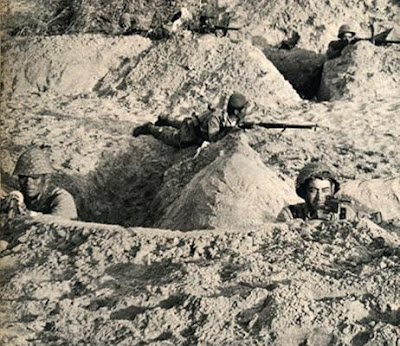
Japanese trenches during the battle
The final Soviet-Mongolian offensive which began in the early morning hours of 20 August and continued brutally until the end of the month used simultaneous forward thrusts of rifle brigades, cavalry divisions, mechanized (motorized) divisions, and airborne brigades to overrun the heights near the river controlled by the Japanese. Supported by early morning bomber runs and frequent fly over’s throughout the rest of the month by ground-attack planes, Zhukov’s final assault opened officially after an almost hour long period of heavy artillery shelling after which the Red Army and MPRA forces of between 60-75,000 men and more than 500 armored vehicles and their support units moved to engage IJA troops at positions in the North, Center, and South of the river.
By this point in August the Soviets had begun to exploit air superiority making infantry and mechanized movement much safer for their own troops throughout the flat landscapes of the river valley. Pushing up methodically through the dry grass plateaus and sand dunes T-26, T-28, and BT-5’s armed with flamethrowers and aided by Red Army grenadiers made contact with and destroyed the forward command posts and defensive emplacements that the IJA had constructed in the weeks before, in a seek and destroy mentality that slowly cut off and enveloped the 23rd’s positions. By the end of August the decisive battle that Zhukov had planned for more than month was nearly won. In the last week from 23-26 August, major efforts were launched to reinforce and break-out the IJA forces trapped but all failed.
In the final dramatic action the 23rd infantry division was almost entirely destroyed along with the more than half of 72nd regiment and most of their supporting armored divisions by the Red Armies 6th armored brigade. No accurate number can be established for the total number of Japanese or Soviet, and Mongolian and Chinese casualties for that matter, though it is possible that these numbers were higher than claimed by most sources. Most likely somewhere between 45,000-60,000 were killed or wounded in total for all sides.
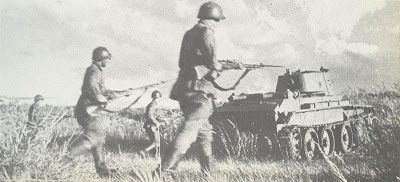
Advancing Soviet troops
Official reports from immediately after put both nations’ total casualties (killed or wounded) at under 20,000 each excluding Mongolian and Chinese deaths related or caused by the conflict. The air war continued past the infantry wars’ conclusion with IJA and Red Army air squarons continuing to duel after the ground war had ended in early September. Negotiations had begun weeks before and a ceasefire was implemented on the 16th of September 1939. This oficially ending the Battle of Khalkhin Gol, the little known or cited “small war” fought in borderlands of Mongolia and China immediately before the buildup to World War II. The influence of this far flung secondary front and its corresponding conflicts in Siberia, on the steppes of Mongolia, and in the prairies of northern China, greatly alterered the diplomatic and military history of 1940-1945 in Eastern Europe and Asia.
Coox, Alvin D. The Anatomy of a Small War: The Soviet-Japanese Struggle for Changkufeng/Khasan 1938. (Greenwood Press, Westport, Connecticut 1997).
(University of Wisconsin 1990, 2005).
(Osprey Publishing, London 1973).

 Copyright © 2024
Copyright © 2024
Leave a Reply